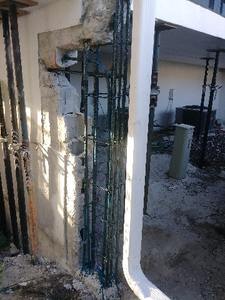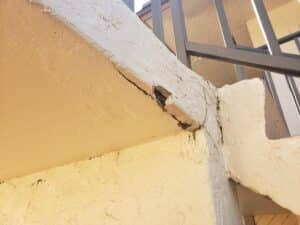Picture this: a commercial building or a cozy condo adorned with pristine, seamless foam trim, exuding an aura of sophistication and elegance. EIFS foam trim repairs breathe new life into aging properties, restoring their visual appeal and structural integrity.
So, let’s go on a captivating journey, unearthing the secrets behind the magic of EIFS foam trim repairs. From the science behind the materials to the artistry involved in the repair process, we leave no stone unturned.
Read on and get ready to witness the transformation of ordinary buildings into extraordinary landmarks with the power of EIFS foam trim repairs.
Common EIFS Foam Trim Issues
Understanding the typical issues affecting EIFS foam trim allows property owners and managers to identify and address potential problems proactively:
1. Cracks: Small cracks and fissures can develop in the foam trim due to settling, natural wear and tear, or impact from external elements. If left untreated, these cracks can allow water infiltration and further damage the foam trim or building structure.
2. Water Infiltration: Poor installation or damaged foam trim can lead to water ingress, causing potential mold growth, rot or other moisture-related problems within the building envelope.
3. Delamination: Delamination occurs when the foam trim separates from the building substrate or finish coat, often resulting from improper bonding or faulty installation. This issue can undermine the structural integrity and aesthetic appeal of the property.
4. Fading: UV exposure and harsh weather conditions can cause the foam trim’s color to fade, altering the exterior appearance and reducing its visual appeal.
Benefits of Timely Repairs
Addressing EIFS foam trim issues promptly brings significant advantages:
1. Lifespan Extension: Timely repairs can not only mend the foam trim’s appearance but also extend its lifespan, safeguarding your investment in both the short and long term.
2. Damage Prevention: Swiftly tackling problems before they escalate can prevent the need for costly repairs and protect the structural integrity of your property,
3. Aesthetic Preservation: Repairing noticeable defects ensures that your building maintains its visual appeal, essential for attracting new clients, tenants, or residents.
4. Structural Stability: Properly maintained foam trim promotes overall structural stability, ensuring a secure and comfortable environment for everyone within the property.
The Repair Process
Conducting EIFS foam trim repairs involves several necessary steps:
1. Damage Assessment: Begin by critically examining the extent of the foam trim’s damage. This process may include visual inspection as well as moisture testing to uncover hidden issues.
2. Preparation: Once the damage is assessed, prepare the area for repair by removing any loose or damaged material, cleaning the surface to ensure proper adhesion, and masking off adjacent areas to protect them during the repair process.
3. Material Selection: Choose replacement foam trim that closely matches the existing product and provides adequate insulation, impact resistance, and visual compatibility.
4. Installation: Adopt appropriate installation techniques, ensuring that the foam trim is properly bonded to the substrate and sealed against moisture infiltration. Apply a finish coat to match the rest of the building’s exterior.
5. Inspection: Following the repair, conduct a thorough inspection to verify the quality and success of the restoration before declaring the project complete.
Tips for Preventative Maintenance
Implementing a proactive preventative maintenance plan for your building’s EIFS foam trim can save time, money, and effort in the long run:
1. Regular Inspections: Schedule periodic visual inspections to detect potential issues or early signs of damage. Address any concerns immediately to prevent escalation.
2. Sealants and Caulking: Keep window and door perimeters, as well as other potential moisture entry points, properly sealed with appropriate sealants and caulking to prevent water infiltration that could damage the foam trim.
3. Cleaning and Maintenance: Maintain a consistent cleaning schedule for your building’s façade to remove dirt, algae, and debris that could cause staining or damage to the foam trim over time.
4. Moisture Management: Ensure proper drainage and moisture barriers to keep water away from the building’s envelope, reducing the risk of moisture-related damage to the foam trim or building structure.
5. Professional Consultation: Consult with an experienced EIFS foam trim specialist to assess your property’s current state, identify potential risks, and receive expert guidance on preventative maintenance best practices.
The Benefits of EIFS Foam Trim Repairs
Preserving the appearance and functionality of your Condo-HOA or commercial property is vital for successful property management and maximizing value. By understanding the common issues affecting EIFS foam trim and implementing our expert tips for timely repairs and preventative maintenance, you can effectively safeguard your investment and maintain your property’s visual appeal.
Schedule your free consultation with McLeod’s Contracting Solutions today, and benefit from our specialized expertise in EIFS foam trim repairs in Fort Myers, ensuring a beautifully maintained exterior for your property while adhering to the highest standards of quality and craftsmanship.







